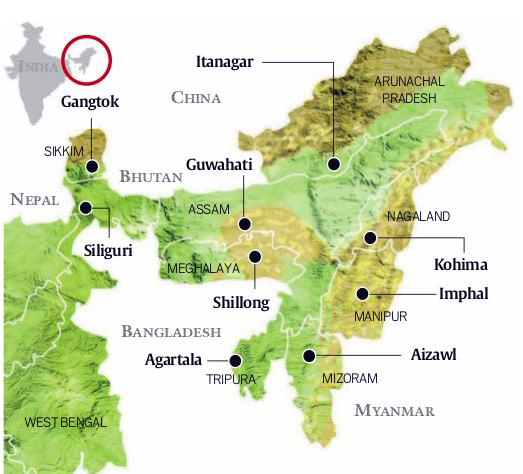Changing Rainfall Pattern in North East India | 13 Sep 2021
Why in News
Recently, an analysis showed a changing rainfall pattern in North East (NE) India because of Climate Change.
- The National Action Plan on Climate Change (NAPCC) was launched in 2008 by the Prime Minister's Council on Climate Change. It identifies measures that promote India's development objectives while also yielding co-benefits for addressing climate change effectively.
Key Points
- About:
- NE normally receives heavy rainfall during the Monsoon months (June-September), but has changed its course in recent years.
- The rains come in quick bursts and Flood the region, followed by elongated dry periods that border on drought.
- A research paper published in 2018 found that the monsoon rainfall in NE decreased by 355 mm between 1979 and 2014.
- Out of this, 30-50 mm decrease was due to a reduction in local Moisture levels.
- Because of its unique topology and steep slopes suddenly giving way to plains, the region is prone to river course changing.
- NE is mostly hilly and is an extension of the Indo-Gangetic Plains, the region is highly sensitive to changes in regional and global climate.
- Pre-monsoon and monsoon are the rainy seasons of northeast India.
- In most of the NE states the rainfall during monsoon has declined in two decades below the Long Period Average (LPA).
- The number of rainy days decreased in most districts to the north of the Brahmaputra.
- This means that increased rainfall now happens over fewer days, increasing chances of river flooding.
- Factors Causing Rainfall Patterns Change:
- Moisture and Drought Together:
- An aspect of warming that influences rainfall is drying of the land, which increases the frequency and intensity of dry periods and Droughts.
- Increase in moisture and the drying up together change the rainfall patterns in unpredictable ways.
- Increased Snowfall in the Eurasian Region:
- Increased snowfall in the Eurasian region also impacts monsoon rainfall in NE India as the excessive snowfall in Eurasia causes cooling of the atmosphere of the region, which triggers events eventually leading to a weak summer monsoon season there.
- Change in Pacific Decadal Oscillation (PDO):
- Sea surface temperatures over the subtropical Pacific Ocean, which vary in a cycle and each phase of which lasts a decade. The peak comes every 20 years and is known as the Pacific Decadal Oscillation (PDO).
- It may have an impact on the monsoon rainfall in NE.
- PDO is also being influenced by global warming as it decreases the difference of temperatures among the layers of the ocean.
- Sea surface temperatures over the subtropical Pacific Ocean, which vary in a cycle and each phase of which lasts a decade. The peak comes every 20 years and is known as the Pacific Decadal Oscillation (PDO).
- Sunspot Epoch:
- During the monsoon, rainfall patterns in NE differed significantly from one Sunspot epoch to another, suggesting differential intensification of the seasonal trough of low pressure over the country.
- Sunspot Epochs are alternating periods of increased and decreased activity on the Sun’s surface that influence the climate of Earth.
- During the monsoon, rainfall patterns in NE differed significantly from one Sunspot epoch to another, suggesting differential intensification of the seasonal trough of low pressure over the country.
- Moisture and Drought Together:
- Impact:
- The changing rainfall pattern, especially during the monsoon season, affects the flow of rivers, extent of snow cover and health of mountain springs, which in turn have an impact on livelihoods, especially agriculture and fishing, forest flora growth, animal and bird habitat (and behaviour) and other ecosystem aspects.
- There is some evidence of rivers such as Subansiri, Dibang (tributaries of Brahmaputra) and Brahmaputra changing courses in unexpected ways.
- Extreme rainfall events being caused by global warming trigger a cascade of events such as accelerated Soil Erosion along the hill slopes devoid of forest cover. This increases surface run-off of rivers and changes their course.
- The changing rainfall pattern, especially during the monsoon season, affects the flow of rivers, extent of snow cover and health of mountain springs, which in turn have an impact on livelihoods, especially agriculture and fishing, forest flora growth, animal and bird habitat (and behaviour) and other ecosystem aspects.

